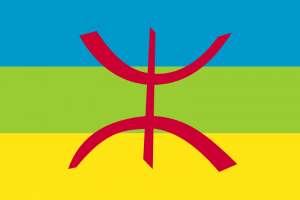Difference between revisions of "Language/Standard-moroccan-tamazight/Vocabulary/Numbers"
m (Quick edit) |
m (Quick edit) |
||
| Line 8: | Line 8: | ||
As a beginner in Tamazight, learning basic numbers is an important step towards improving your language skills. Knowing how to count and use numbers in Tamazight can help you with many everyday tasks like shopping, telling time, and making appointments. In this lesson, we will learn how to count in Tamazight and use numbers in various contexts. | As a beginner in Tamazight, learning basic numbers is an important step towards improving your language skills. Knowing how to count and use numbers in Tamazight can help you with many everyday tasks like shopping, telling time, and making appointments. In this lesson, we will learn how to count in Tamazight and use numbers in various contexts. | ||
<span link>Don't hesitate to look into these other pages after completing this lesson: [[Language/Standard-moroccan-tamazight/Vocabulary/Days-of-the-week|Days of the week]] & [[Language/Standard-moroccan-tamazight/Vocabulary/Places-in-Town|Places in Town]].</span> | |||
== Counting in Tamazight == | == Counting in Tamazight == | ||
| Line 81: | Line 83: | ||
|keywords=Tamazight numbers, counting in Tamazight, Tamazight language course, Standard Moroccan Tamazight, learn Tamazight | |keywords=Tamazight numbers, counting in Tamazight, Tamazight language course, Standard Moroccan Tamazight, learn Tamazight | ||
|description=In this lesson, you will learn how to count and use numbers in Tamazight. We will cover basic numbers, how to use them in various contexts, and exercises to help you practice. }} | |description=In this lesson, you will learn how to count and use numbers in Tamazight. We will cover basic numbers, how to use them in various contexts, and exercises to help you practice. }} | ||
{{Standard-moroccan-tamazight-0-to-A1-Course-TOC}} | {{Standard-moroccan-tamazight-0-to-A1-Course-TOC}} | ||
| Line 90: | Line 91: | ||
[[Category:Standard-moroccan-tamazight-0-to-A1-Course]] | [[Category:Standard-moroccan-tamazight-0-to-A1-Course]] | ||
==Other Lessons== | |||
== | |||
* [[Language/Standard-moroccan-tamazight/Vocabulary/Count-to-10|Count to 10]] | * [[Language/Standard-moroccan-tamazight/Vocabulary/Count-to-10|Count to 10]] | ||
* [[Language/Standard-moroccan-tamazight/Vocabulary/Parts-of-the-Body|Parts of the Body]] | * [[Language/Standard-moroccan-tamazight/Vocabulary/Parts-of-the-Body|Parts of the Body]] | ||
| Line 104: | Line 104: | ||
{{Standard-moroccan-tamazight-Page-Bottom}} | {{Standard-moroccan-tamazight-Page-Bottom}} | ||
<span links></span> | |||
Revision as of 23:04, 27 March 2023
As a beginner in Tamazight, learning basic numbers is an important step towards improving your language skills. Knowing how to count and use numbers in Tamazight can help you with many everyday tasks like shopping, telling time, and making appointments. In this lesson, we will learn how to count in Tamazight and use numbers in various contexts.
Don't hesitate to look into these other pages after completing this lesson: Days of the week & Places in Town.
Counting in Tamazight
Tamazight uses a base-10 numeral system, which means that numbers are written using digits 0-9. Here are the numbers from 1 to 10 in Tamazight:
| Standard Moroccan Tamazight | Pronunciation | English |
|---|---|---|
| yi | iː | one |
| sin | sˤin | two |
| kḍaṛ | kˤdaɾ | three |
| kkuż | kˤkuz | four |
| smnu | sˤmnu | five |
| sdis | sd͡zis | six |
| sa | sa | seven |
| tam | tˤam | eight |
| tẓit | tˤzit̠ | nine |
| ašer | aʃəɾ | ten |
To form numbers higher than ten, you can simply combine the basic numbers. For example, 11 would be yi ma ašer, which combines "one" and "ten." Here are a few more examples:
| Standard Moroccan Tamazight | Pronunciation | English |
|---|---|---|
| atni-n sin | ɑtnin sˤin | twelve (lit. "ten and two") |
| aẓar n- kḍaṛ | ʕaẓaɾ n kˤdaɾ | 13 (lit. "ten and three") |
| arbaʕ n- kkuż | aɾbaʕ n kˤkuz | 14 (lit. "ten and four") |
| smun u sdis | sˤmun u sd͡zis | 56 (lit. "five and six tens") |
Note that when you count items, you also need to use the feminine form of the numbers. For example, to say "two books" in Tamazight, you would say sin n tgommi, where tgommi ("books") is feminine.
Using Numbers in Tamazight
Knowing how to count is only the first step. Here are a few more situations where you can use numbers in Tamazight:
- Telling time: In Tamazight, you can state the exact time using numbers. For example, four o'clock would be arbaʕa f-ssbaḥ. - Age: To tell someone's age in Tamazight, you use the verb yelli ("to have"), followed by the age. For example, "I am thirty years old" would be n-yelli tlat msan. - Phone numbers: When giving a phone number in Tamazight, you can simply use the digits instead of spelling it out. For example, "my phone number is 0678 23 45 67" would be "Ḥa lqṭeli fone 0678 23 45 67." - Quantities: When counting items or expressing quantities, you can use the numbers you learned. For example, "I have two chairs" would be "Ghadi n-kkam sgya sin."
Practice
Here are a few exercises to practice counting in Tamazight:
1. How do you say "sixty-nine" in Tamazight? 2. What is the word for "three" in Tamazight? 3. How do you say "I am twenty years old" in Tamazight?
Answers:
1. tmezgida t tẓit 2. kḍaṛ 3. N-yelli ūišrin msan.
Keep practicing and soon, you'll be able to count in Tamazight like a native speaker!
Other Lessons
- Count to 10
- Parts of the Body
- Travel Dialogue Practice
- Health
- Fruits
- Days of the Week
- Education
- Feelings and Emotions
- Food
- Count from 1 to 10
